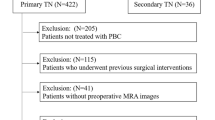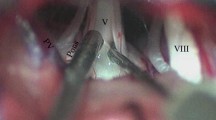Abstract
Objective
To evaluate the effectiveness of percutaneous balloon compression (PBC) in treating trigeminal neuralgia (TN) and determine improvements in quality of life (QoL) and daily functional status.
Methods
Data from primary TN (pTN) patients treated with PBC from December 2018 to April 2021 were retrospectively analyzed. Short-Form 36 (SF-36) Health Survey and Functional Independence Measure (FIM) assessments were used to evaluate patients’ QoL and physical function every 6 months after surgery, and facial pain was evaluated every 3 to 6 months post-surgery.
Results
A total of 80 pTN patients were enrolled for analysis. The Barrow Neurological Institute (BNI) scores of I-II were achieved in 67 (83.8%) patients immediately after the surgery. The estimated rates of BNI I-II pain relief at one, two, and three years were 94.2%, 87.6%, and 83.2%, respectively. All aspects of the SF-36 questionnaire were significantly improved after the PBC, especially in terms of role physical (RP), bodily pain (BP), and social functioning (SF). Patients’ functional outcomes measured by FIM at the 6-month follow-up examination were 108.6 ± 9.9, which was significantly improved compared with the pretreatment scores (90.8 ± 12.7). There was no difference between the severity of facial numbness in FIM and any item of the SF-36 except RP (P = 0.004) at 6 months after surgery. There was also no difference in SF-36 and FIM between patients with or without facial hyperalgesia.
Conclusions
PBC can produce long-term and stable pain relief and significantly improve the patient’s QoL and physical function. However, further well-designed, high-level, evidence-based studies are needed to precisely assess the efficacy of PBC for pTN patients.






Similar content being viewed by others
Data Availability
The data that support the findings of this study are available on request from the corresponding author. The data are not publicly available due to privacy or ethical restrictions
Abbreviations
- BNI:
-
Barrow Neurological Institute
- TN:
-
trigeminal neuralgia
- PBC:
-
percutaneous balloon compression
- FO:
-
foramen ovale
- MC:
-
Meckel’s cave
- PTN:
-
primary trigeminal neuralgia
- MRI:
-
magnetic resonance image
- FIM:
-
functional independence measure score
References
Abdennebi B, Mahfouf L, Nedjahi T (1997) Long-term results of percutaneous compression of the gasserian ganglion in trigeminal neuralgia (series of 200 patients). Stereotact Funct Neurosurg 68(1-4 Pt 1):190–195
Asplund P, Blomstedt P, Bergenheim AT (2016) Percutaneous balloon compression vs percutaneous retrogasserian glycerol rhizotomy for the primary treatment of trigeminal neuralgia. Neurosurgery 78(3):421–428
Barker FG 2nd (2007) Quality of life and individual treatment choice in trigeminal neuralgia. Pain 131(3):234–236
Bendtsen L et al (2020) Advances in diagnosis, classification, pathophysiology, and management of trigeminal neuralgia. Lancet Neurol 19(9):784–796
Beloeil H et al (2013) Guidelines for regional anesthetic and analgesic techniques in the treatment of chronic pain syndromes. Ann Fr Anesth Reanim 32(4):275–284
Bick SKB, Eskandar EN (2017) Surgical treatment of trigeminal neuralgia. Neurosurg Clin N Am 28(3):429–438
Brazier JE, Harper R, Jones NM et al (1992) Validating the SF-36 health survey questionnaire: new outcome measure for primary care. BMJ (Clinical research ed) 305(6846):4
Brown JA et al (1996) Axon and ganglion cell injury in rabbits after percutaneous trigeminal balloon compression. Neurosurgery 38(5):993–1003
Brown JA, Pilitsis JG (2005) Percutaneous balloon compression for the treatment of trigeminal neuralgia: results in 56 patients based on balloon compression pressure monitoring. Neurosurg Focus 18(5):E10
Chen JF, Tu PH, Lee ST (2011) Long-term follow-up of patients treated with percutaneous balloon compression for trigeminal neuralgia in Taiwan. World Neurosurg 76(6):586–591
Cheng JS et al (2014) A review of percutaneous treatments for trigeminal neuralgia. Neurosurgery 10(Suppl 1):25–33
Cuschieri S (2019) The STROBE guidelines. Saudi J Anaesth 13(Suppl 1):S31–s34
D'Andrea A et al (2020) Functional Independence Measure score is associated with mortality in critically ill elderly patients admitted to an intermediate care unit. BMC Geriatr 20(1):334
Diana C et al (2021) Does the surgical intervention for trigeminal neuralgia refractory to pharmacotherapy improve quality-of-life? - a systematic review. J Oral Maxillofac Surg 79(11):2227–2239
Haviv Y et al (2017) The impact of chronic orofacial pain on daily life: the vulnerable patient and disruptive pain. Oral Surg Oral Med Oral Pathol Oral Radiol 123(1):58–66
Kourilsky A et al (2022) Multivariate models to predict pain recurrence and sensitive complications after percutaneous balloon compression in trigeminal neuralgia. J Neurosurg:1–10
Little AS et al (2008) Long-term pain response and quality of life in patients with typical trigeminal neuralgia treated with gamma knife stereotactic radiosurgery. Neurosurgery 63(5):915–923
Li MW, Jiang XF, Niu CS (2021) Efficacy of and risk factors for percutaneous balloon compression for trigeminal neuralgia in elderly patients. Br J Neurosurg 35(3):280–284
Luo Y et al (2019) A research on quality of life score (QOLS) of patients with trigeminal neuralgia (TN). J Infect Public Health 12(5):690–694
Liu MX et al (2021) Treatment of trigeminal neuralgia with “microvascular decompression plus” technique. J Neurol Surg B Skull Base 82(Suppl 3):e295–e299
Lv W et al (2022) Factors that may affect recurrence of trigeminal neuralgia after percutaneous balloon compression. J Clin Neurosci 99:248–252
Mullan S, Lichtor T (1983) Percutaneous microcompression of the trigeminal ganglion for trigeminal neuralgia. J Neurosurg 59(6):1007–1012
Nascimento RFV, Pipek LZ, de Aguiar PHP (2023) Is percutaneous balloon compression better than microvascular decompression to treat trigeminal neuralgia? A systematic review and meta-analysis. J Clin Neurosci 109:11–20
Nurmikko TJ (2017) Toward an etiology-based management of trigeminal neuralgia. Pain Manag 7(3):149–154
Otsu Y et al (2023) Effects of microvascular decompression on pain relief and quality of life in late elderly patients with trigeminal neuralgia. Neurol Med Chir (Tokyo)
Sterman-Neto H et al (2021) Balloon compression vs radiofrequency for primary trigeminal neuralgia: a randomized, controlled trial. Pain 162(3):919–929
Spatz AL, Zakrzewska JM, Kay EJ (2007) Decision analysis of medical and surgical treatments for trigeminal neuralgia: how patient evaluations of benefits and risks affect the utility of treatment decisions. Pain 131(3):302–310
Symonds T et al (2018) Measuring the impact of trigeminal neuralgia pain: the Penn Facial Pain Scale-Revised. J Pain Res 11:1067–1073
The International Classification of Headache Disorders (2013) 3rd edition (beta version). Cephalalgia 33(9):629–808
Torres A (2018) Capturing Functional Independence Measure (FIM(R)) ratings. Rehabil Nurs 43(1):3–11
Wang H et al (2022) Clinical analysis of the treatment of primary trigeminal neuralgia by percutaneous balloon compression. Front Surg 9:843982
Yadav YR et al (2017) Trigeminal neuralgia. Asian J Neurosurg 12(4):585–597
Ying X et al (2017) Long-term outcome of percutaneous balloon compression for trigeminal neuralgia patients elder than 80 years: a STROBE-compliant article. Medicine (Baltimore) 96(39):e8199
Zakrzewska JM, Linskey ME (2014) Trigeminal neuralgia. BMJ. Clin Evid:2014
Zhao H et al (2018) Outcomes of two-isocenter gamma knife radiosurgery for patients with typical trigeminal neuralgia: pain response and quality of life. World Neurosurg 109:e531–e538
Author information
Authors and Affiliations
Corresponding authors
Ethics declarations
Conflict of interest
The authors declare no competing interests.
Additional information
Comments
The authors of this article analyzed the size of the trigeminal nerve root in a series of patients with trigeminal neuralgia (TN) and discovered a higher likelihood of successful pain relief with percutaneous balloon compression in those who exhibited asymmetry between the affected and unaffected sides.
It remains unclear if the observed correlation has anything to do with the underlying mechanism of pain or the specific way the balloon compression produces long-lasting pain relief in TN patients. It is conceivable that nerve asymmetry is the reason TN patients develop pain in the first place, but the asymmetry may also be a result of prolonged nerve malfunction in TN patients when the nerve atrophies due to vascular compression or subsequent focal demyelination.
I applaud the authors for their thorough analysis of their clinical series but feel that it would be too early to make any recommendations in terms of choice of treatment approach or its technical details based on preoperative nerve morphometry.
Konstantin Slavin,
Chicago, USA
Publisher’s Note
Springer Nature remains neutral with regard to jurisdictional claims in published maps and institutional affiliations.
Rights and permissions
Springer Nature or its licensor (e.g. a society or other partner) holds exclusive rights to this article under a publishing agreement with the author(s) or other rightsholder(s); author self-archiving of the accepted manuscript version of this article is solely governed by the terms of such publishing agreement and applicable law.
About this article
Cite this article
Huang, P., Liu, H., Liu, Z. et al. Effectiveness of percutaneous balloon compression (PBC) in improving physical function and quality of life in trigeminal neuralgia: a retrospective study. Acta Neurochir 165, 3905–3912 (2023). https://doi.org/10.1007/s00701-023-05823-z
Received:
Accepted:
Published:
Issue Date:
DOI: https://doi.org/10.1007/s00701-023-05823-z




